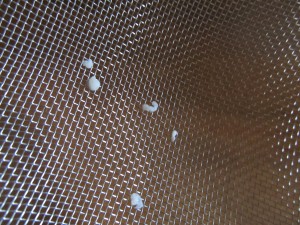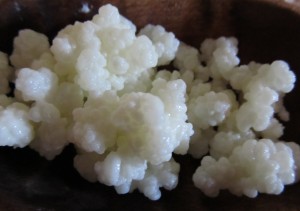Milk Kefir Myths
There’s lots of misinformation on the internet–especially when it comes to milk kefir and other ferments. I watched a great video not too long ago that explained exactly how to make milk kefir. There were lots of people commenting that the instructions were wrong. This person had been making milk kefir for years, hadn’t killed the grains, and had successfully made kefir. So how wrong could those instructions have been? The only thing I disagreed with in their video, was the use of a colander to strain out the grains instead of a metal, fine-mesh strainer.
Many people use a plastic colander to strain their grains when the kefir is finished because they’ve been misinformed (as I was) about using metal with kefir grains and other ferments. Using a plastic mesh strainer might be okay for water kefir, but is impossible for milk kefir; it takes forever for the kefir to strain through. Using a colander with big holes allows the babies to slip through and yes, you’re eating/drinking your babies. It’s not that it is wrong to eat your baby kefir grains; you miss out on growing extras that can be gifted to friends and family, or sold. If you use a metal, fine-mesh strainer, you can rinse the strainer and see the small babies left behind. Yes, those are the babies you are eating since they’re slipping through the colander holes. Using a metal, fine-mesh strainer makes it easy to save those small babies so you can let them grow, dry them for later, or give them to a friend.
Stainless Steel Is Okay To Use

Now you’re saying, “you can’t use metal with kefir grains.” Sorry. You’re wrong. Stainless steel is fine. Do not use any other metal and make certain the metal you’re using is, in fact, stainless steel. I’ve been using stainless steel for years and never had a problem. I personally wouldn’t store kefir or the grains in metal or even plastic–I always use glass. And yes, it’s perfectly fine to use a stainless-steel spoon to transfer the grains. If you feel better using a plastic colander, at least line it with a fine mesh cheesecloth like this one so you don’t unknowingly eat/drink your babies.
It’s Easy to Wake Up Your Kefir Grains
If using pasteurized milk, there’s nothing special to do when you receive your grains other than if they’re dried, they need to be re-hydrated (activated). Follow the instructions that came with your grains. If using raw milk, they must be transitioned. Raw milk contains bacteria that the kefir grains need to get used to.
If you don’t have time for making milk kefir, check out high-quality probiotics here at my Fullscript Store:
Make Healthier Choice’s Fullscript Store
20% off and free shipping at $50!
I don’t ever rinse my kefir grains unless they’ve been sitting in the refrigerator for an extended period, because rinsing can weaken them. The only other time is after I strain my kefir, I rinse the bottle and strainer to find the babies. You’ll know if your grains need a rinse. They can go right from milk kefir into the new milk. NEVER rinse kefir grains with chlorinated or fluoridated water, as these chemicals can damage them. Chlorine’s job in the water is to kill bacteria, so you can imagine it would also kill the good bacteria in the grains.
They’re Not Grains
Remember that the Grain in Kefir Grain doesn’t mean it’s a true grain; it’s a SCOBY – a Symbiotic Colony of Bacteria and Yeast. They are living organisms and it’s important to take good care of them. Keeping them alive can sometimes be a challenge, especially if a vacation is on the schedule. I keep mine, tightly covered, in fresh, raw milk in a glass jar in the refrigerator for about two weeks. They’ve gone a bit longer and survived, but I try to give them new milk every two weeks.
Kefir grains actually look more like cauliflower than they do a grain:

Learn how to make Milk Kefir.
Here’s a short how-to video:
Leave a Reply